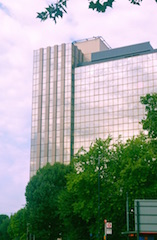 Arts Alliance Media first opened its doors in London June 17, 2003. In those very early days of digital cinema, the new company and its ten employees carved out a space in technology and what was then called alternative content. The company divested itself of the alternative content business a few years ago to focus on what has long been its core strength: cinema technology. AAM launched its first theatre management system in 2007 and, in 2008, completed the first virtual print fee rollout in Europe with French chain CGR. Today AAM has more than 140 employees spread over three offices in London, Amsterdam, and Guangzhou, China. I recently spoke via email with AAM’s chief executive officer Patrick Foley, and chief technology officer Richard Phillips about those early days of the company and, more importantly, to get their thoughts about the future of digital cinema technology.
Arts Alliance Media first opened its doors in London June 17, 2003. In those very early days of digital cinema, the new company and its ten employees carved out a space in technology and what was then called alternative content. The company divested itself of the alternative content business a few years ago to focus on what has long been its core strength: cinema technology. AAM launched its first theatre management system in 2007 and, in 2008, completed the first virtual print fee rollout in Europe with French chain CGR. Today AAM has more than 140 employees spread over three offices in London, Amsterdam, and Guangzhou, China. I recently spoke via email with AAM’s chief executive officer Patrick Foley, and chief technology officer Richard Phillips about those early days of the company and, more importantly, to get their thoughts about the future of digital cinema technology.
Digital Cinema Report: What was the inspiration for launching Arts Alliance Media fifteen years ago?
Patrick Foley: Our founders, Arts Alliance Ventures, led by Thomas Hoegh, were very interested in what happened when technology and media intersected. By 2003, everything from music to home entertainment had gone through some kind of digital transformation; the only form of media that hadn’t yet was cinema. So, they wanted to invest in a digital cinema portfolio, and particularly to start a business that would be prepared to play a part in the transition when the opportunity arose.
Richard Phillips: We knew it was going to be a transformation where we could have significant impact on the industry if we were there at the beginning to understand it. Picturehouse Cinemas was already within our portfolio of companies, so we had been experimenting with very early digital cinema technology across the chain- some of the first prototype digital cinema projectors and satellite broadcasting technology, for example. When I joined AAM, we had been installing prototype equipment into theatres and running some events to promote this technology for a few months, and then we became aware of the UK Film Council’s digital screen initiative.
DCR: And that was the project that first really propelled AAM, wasn’t it?
PF: Yes, it was. It was an initiative funded by the UK National Lottery to give the general public better access to content that wasn't mainstream (art house, foreign films, documentaries) and to do that not just through independent cinemas but also through major cinemas too. The UK Film Council was incentivizing cinemas to participate in the program by converting them to digital in exchange for their agreement to show more specialized content. This was the opportunity that we had been anticipating: the creation of the UK’s first digital screen network.
 DCR: It was a bit of a Cinderella story, wasn’t it?
DCR: It was a bit of a Cinderella story, wasn’t it?
PF: It did feel like it at the time. They were looking for an integrator to install, support, and maintain this new digital cinema network. Big names like Dolby, BT, Deluxe and Technicolor all went through the tender process, and then this start-up that was based in a little converted church won the €20m contract. And we won that contract because we understood cinematic operations, thanks to our work in Picturehouse Cinemas. We approached the tender from an angle of simplifying our own operations, rather than simply as an IT project.
RP: It put us right where we wanted to be- at the very cutting-edge. The UK Film Council had specified that if the DCI (Digital Cinema Initiatives) were published, then the digital screen network we were building had to be compatible with it. However, the DCI specifications were still being debated, so we had to figure out how to be compliant with it before it was even finalized. We were working with the manufacturers to make sure the equipment they were building was suitable, we were talking to the people who were in the room deciding on the DCI, and we were engaging with some of the studios to understand how the DCI might influence decisions that we were making for the UK Film Council. At the same time, we got to define how to deploy all of this, how to integrate it into existing cinemas, how to support it, and even how the content chain was going to work, because none of that existed.
DCR: So, what did that project help you lay the groundwork for?
RP: Building those relationships with manufacturers, distributors, and exhibitors right at the beginning has been instrumental to our success. It was also the first way to build the credibility for, not just AAM, but also the implementation of the technology. We were proving that digital conversion was viable in Europe, even in its earliest form.
PF: We knew once the proof of concept was out there, commercial models would develop, and that we would be very well placed to act on them. When virtual print fees were decided on as the key funding mechanism for the transition in the USA, we were already entering into negotiations for creating a European VPF model with the major Hollywood Studios. That's where I got involved when I first came on as the CFO in 2006; building the business model for converting 7,500 screens in Europe. Once that was done, my role was to raise the capital needed to complete the conversions. At that time it cost anywhere between $60,000 and $100,000 per screen, so that was a significant amount of financing we secured. Which was our next big win, of course, and paved the way for the next phase of our business.
 DCR: And that’s when AAM first saw the potential software held for the cinema industry?
DCR: And that’s when AAM first saw the potential software held for the cinema industry?
PF: I think everyone understood from the outset that once the digital network was created it was going to be a huge enabler. There was enormous potential for improving the overall visibility along and within the whole content chain, providing better access to data, greater efficiency, and simplified operations. Once it was deployed, it wasn’t just going to replace its analogue counterparts, it was going to upgrade the whole industry’s capabilities. To deliver on that promise, we knew the industry would need robust software solutions at their heart.
RP: During our very first VPF deployments, we actually purchased a third party theatre management system before we recognized that there was an opening there. The TMSs on offer at the time weren’t really concerned with being the foundation for the industry’s future, so we took the decision to begin developing our own.
DCR: What was the industry debating back then, and what are they debating now?
RP: The issue I remember most was the political debate that Europe and the US were embroiled in about the DCI. Europe viewed the DCI almost as bullying from Hollywood, and didn’t think the US had any regard for their own regional requirements. And the US didn’t think Europe was concerned enough about the security of their content, when the fear of piracy was really the main driving force behind DCI. If you look at the actual document, the first quarter is technical specifications but the remaining three quarters are security specifications. Without taking sides on that particular political debate, I do think that without the catalyst of DCI it would have been quite difficult to agree specifications and standardization so early on, so I think it's had a positive impact on the industry overall.
PF: Back then standardization was effectively enforced because you couldn’t sign up for a VPF deal without being fully DCI compliant. It’s a good example of why the industry has to keep rethinking practices that have already been set in order to keep evolving. Once the VPF deals come to an end, how will we, as an industry, ensure the DCI still has the power to maintain standards? That’s a debate we should be having.
 RP: And how can we start to expand the standards now. I think we need to update the DCI with standards for new customer facing technology. We have all these great new sound and picture formats, 4D seats, and premium large format offerings today, and though all this innovation is fantastic, it's easy to get caught up in spreading terms that can be confusing for consumers. I think everyone could benefit from some common standards and some categorisation around the different types and levels of cinematic experiences that consumers can understand and manufacturers can build to.
RP: And how can we start to expand the standards now. I think we need to update the DCI with standards for new customer facing technology. We have all these great new sound and picture formats, 4D seats, and premium large format offerings today, and though all this innovation is fantastic, it's easy to get caught up in spreading terms that can be confusing for consumers. I think everyone could benefit from some common standards and some categorisation around the different types and levels of cinematic experiences that consumers can understand and manufacturers can build to.
PF: It should always come back down to the customer experience. The industry is hyper-aware that we need to maintain the relevancy of the cinematic experience because there are more things competing for consumers’ time and money than ever.
RP: And if you look at what's happened over recent years in terms of addressing that relevancy – refitting cinemas with recliner seats, providing higher quality food and beverage offerings – it’s all great for the bottom line, but it is appealing to an older and older demographic. We know that young people are consuming content differently, that they make purchasing decisions differently, and that their attention span is different. If we’re not careful we’ll lose track of the younger demographic, and the hypothetical debates we are having today about maintaining relevancy will have much realer consequences.
DCR: What is your vision for the future of cinema software?
RP: At the moment, there are quite a lot of disparate processes along the chain, where you start with exhibitors figuring out what content they are interested in and negotiating the rights for it, and end with somebody else making sure the key delivery messages and content are on the right servers, ready for playback. In between those steps, a whole host of people and systems have to complete a series of labor-intensive, technically complex tasks in isolation to make every screening possible. Over the coming years, I think a lot of these processes are going to collapse down into one integrated solution. A flexible, end-to-end solution that takes a lot of the technical skill, and risk, out of getting the right film onto the right screen. Ultimately, we should all be working towards creating a more dynamic system that will allow the whole industry to become more responsive to what consumers want on a much more immediate basis.
 DCR: It seems like you’ve already started to build that future, given the KDM management solution you are now offering in collaboration with Deluxe Technicolor Digital Cinema.
DCR: It seems like you’ve already started to build that future, given the KDM management solution you are now offering in collaboration with Deluxe Technicolor Digital Cinema.
PF: It’s a great first step. What we’ve been able to achieve by serving as the conduit between DTDC and our existing Screenwriter TMS customers really illustrates how much potential there still is for creative solutions within the network we’ve already built. All we have done is looked at the two ends of the process- DTDC generating the KDMs, and cinemas ingesting them into their playback equipment, and presented a path that joins them together. Finding that one path led us to providing two completely separate parts of the industry with the results they had wanted for years- DTDC now gets proof of delivery for their KDMs, and cinemas don’t have to worry about managing their KDMs, they simply appear directly into their servers. If we, as an industry, can join together all of these fragmented manual processes with automated software platforms, it will change booking patterns, it will change scheduling patterns, it will change the way that people consume content and even what content they consume. I think it will be less about a single piece of software, and more about creating an industry-wide ecosystem. That ecosystem is going to enable us to be more like, and compete with, the dynamic media formats that people are using today, in terms of our ability to understand what the customer wants and fulfilling that desire immediately.
DCR: So where do you think AAM fits into achieving that vision?
RP: I think we will realize our value as a facilitator, as the ecosystem provider in that model. We can act as a technological hub for the industry, removing the friction between all those disconnected processes we talked about earlier. We have the strong relationships with all the industry players and the experience with the technology they all use that would be needed to find and connect all those pathways from the centre.
PF: We already have a relatively central vantage point, and we have the experience developing large, scalable software platforms while addressing the challenges specific to the cinema environment. Over the next few years, we will be looking to expand on another of our core competencies: our reach. Our solutions touch 40,000 screens worldwide, and counting, and achieving critical mass is paramount to delivering on the promise of digital cinema. I firmly believe that partnering with companies who have different core competencies to connect even more screens together will streamline the entire industry’s operations. In this age of digital natives – in audiences, competitors, and new suppliers alike – a connected industry will provide cinemas with the resilience and flexibility they need to succeed.
